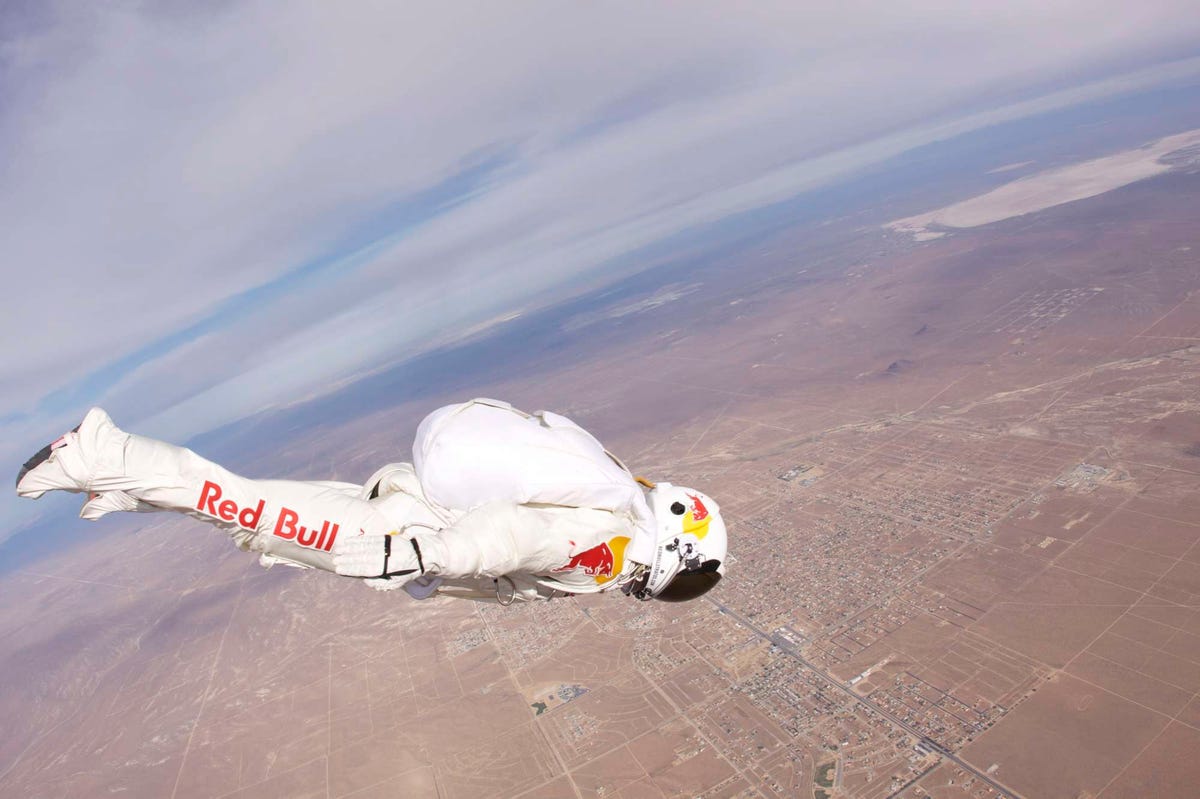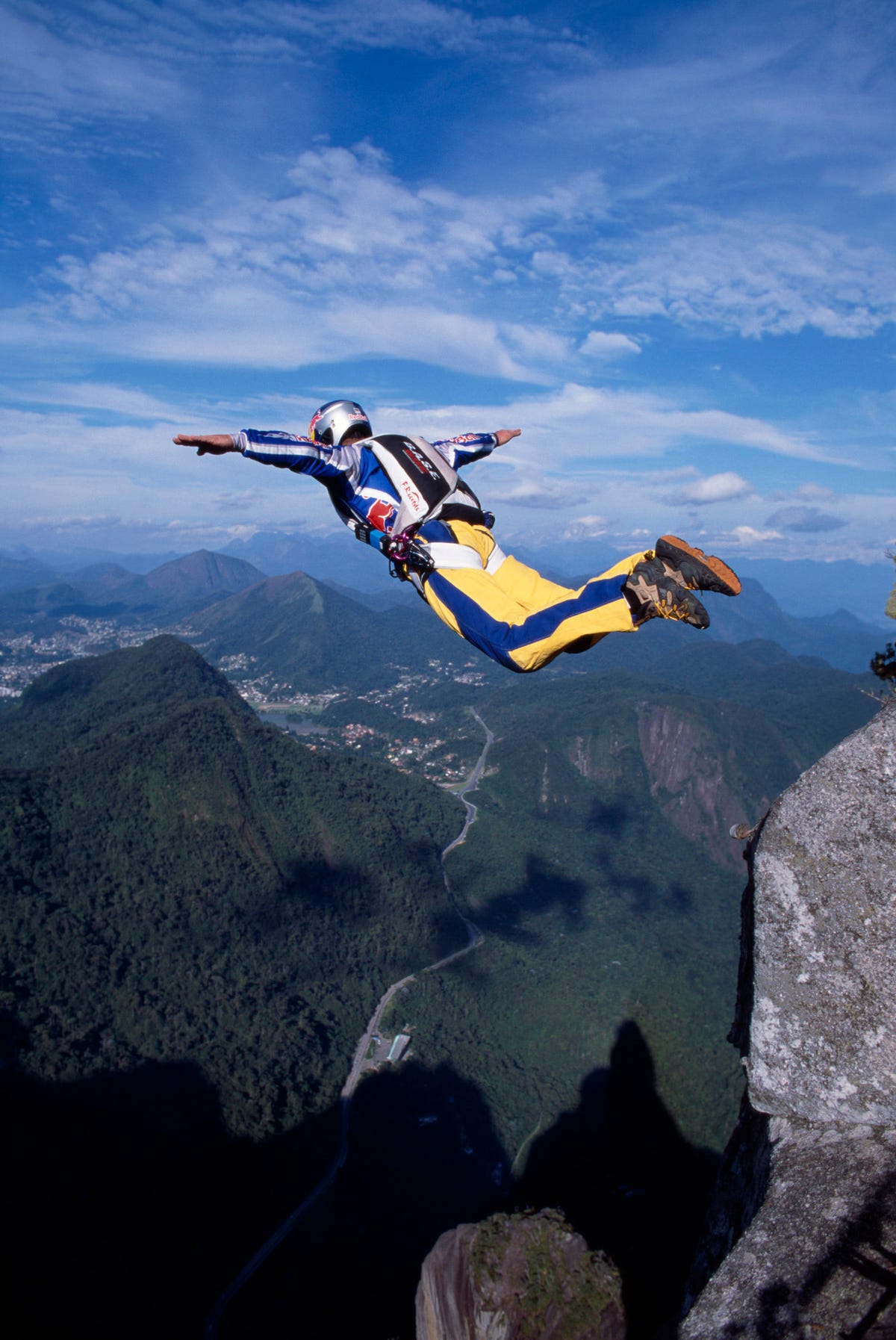The quest for the supersonic skydive (photos)
Felix Baumgartner plans to ride a balloon to an altitude of 120,000 feet and then jump. In freefall on the way down, the veteran skydiver aims to hit Mach 1.

Skydive over Mojave Desert
Aircraft have been traveling faster than the speed of sound--no simple accomplishment--since 1947. Now Felix Baumgartner wants to do the same thing, in freefall. Sometime this year, Baumgartner plans to step out of a balloon-suspended capsule at about 120,000 feet, not so very far from the edge of space, and race toward the earth at a rate that could reach Mach 1 or even slightly above.
It's an endeavor that requires intense and thorough preparation, as well as exacting technique. Baumgartner has been working toward the skydive for months with his Red Bull Stratos support team, and he'll draw on his own experience of more than 2,000 parachute jumps, often extreme in their own right, if nowhere near the breathtaking ambition of this stratospheric undertaking.
The photo here shows Baumgartner in a high-altitude test jump last year, somewhere way above the Mojave Desert in California.
Pressurized suit
Humans aren't built for such extreme altitudes, so Baumgartner will wear a full-pressure suit--essentially a spacesuit--to protect against the dangers of extreme cold, too little oxygen, and really, really low air pressure (think the bends, or worse). The chest pack will include a GPS system and data logger to help determine the speed of his descent. The custom-fit suit and helmet were modeled on those used by pilots of high-altitude reconnaissance aircraft.
As much as the suit protects him, it presents challenges as well. When it's pressurized--to 3.5 pounds per square inch before he exits the capsule--Baumgartner will experience a good deal of sensory deprivation. In testing, he discovered that it was difficult to find the handles of his parachutes, which led to modifications in the design, including mirrors on the gloves to help him see his equipment.
Helmet and gloves
The helmet has a microphone and earphones so Baumgartner can communicate with his mission control team, and its visor has an integrated heating circuit to help prevent fogging and icing, along with being designed to be distortion-free in the critical vision area. It'll also provide Baumgartner with 100 percent oxygen from cylinders in his gear.
In freefall, Baumgartner will need to coax every bit of mobility he can from the bulky, pressurized suit in order to properly position himself in a streamlined "delta" position. He'll also need to deal with the unknown and potentially tricky effects of transonic speed (that is, approaching Mach 1) on the human body. Moving that fast, a very real danger is a rapid, complex, hard-to-control spin, and to guard against that, he'll also have a small drogue parachute that could be deployed early on, in advance of his main chute.
Baumgartner and Kittinger
That's Baumgartner on the left. He's shaking hands in January of this year with Joseph Kittinger, who a half-century ago came exceedingly close to what Baumgartner will be attempting. As an officer in the U.S. Air Force, Kittinger was involved in very high-altitude research that helped pave the way for manned space travel. Among those vertiginous research efforts was Project Excelsior, which sought to answer questions such as: Could someone escape from a high-flying aircraft or space capsule using a parachute? Could a person even survive at an extreme altitude?
"The highest step in the world"
In Project Excelsior, a gondola was suspended beneath a massive research balloon, which Kittinger would pilot high above Earth--and then exit. In November and December of 1959, he made two jumps, the first from 76,000 feet and the second from almost as high, at 74,700 feet. Then, on August 16, 1960, he went even closer to space. This photo shows him ready to go on that date, in the Excelsior III mission. On the threshold of the gondola you can see the words: This is the highest step in the world.
Kittinger jumps
For the Excelsior III mission, Kittinger rose to an altitude of 102,800 feet, or 19.5 miles above sea level. He stayed there in the open gondola for 12 minutes, enduring temperatures as low as minus 94 degrees Fahrenheit and severe pain in his right hand because his glove had failed to inflate. When he jumped, according to the U.S. government's Centennial of Flight account, his 6-foot drogue parachute deployed 13 seconds later to stabilize against a potentially fatal spin; his main, 28-foot parachute would open 4 minutes, 36 seconds later, at which point he was only about 17,500 feet above the Earth.
In the freefall, Kittinger traveled as fast as 614 miles per hour, remarkably close to the speed of sound. It was only his 33rd parachute jump. This picture shows him starting his descent.
Kittinger and pressure suit
"The most fascinating thing is that it's just black overhead. The transition from the familiar blue sky to black is very stark. You can't see stars because there's a lot of glare from the sun," Kittinger wrote in Plane & Pilot magazine recently. (In this photo from an unspecified date, he's being helped with his pressure suit.)
"When I jumped," he continued, "I was thinking simply that it was the beginning of a test. I had done it a hundred times in an altitude chamber and a thousand times in my mind, so I was prepared and confident. But after I jumped, I rolled over and looked up, and there was the balloon just roaring into space. I realized, however, that the balloon wasn't really roaring into space--I was going down at a fantastic rate! At about 90,000 feet, I reached approximately 614 mph. At that point, my altimeter was unwinding very rapidly, but there was no sense of speed because we determine speed visually when we see something go flashing by, and there were no visual cues."
Low-pressure chamber
Preparation for the 2010 supersonic freefall involves lots of testing for Baumgartner and his equipment. Here, he and his pressure suit are being checked out in a low-pressure chamber at a U.S. Air Force base. (The white object in the lower-left corner of the window is his helmet.)
Because of the thin air in the vicinity of 120,000 feet and the limited movement provided by the pressurized suit, Baumgartner will have to choreograph his initial movements for when he exits the gondola. The Red Bull Stratos team says that although at that altitude he'll be above 99 percent of Earth's atmosphere, he'll still feel virtually the same gravity as on the ground--despite being in a near-space environment, he'll hardly be weightless. In fact, because of the weak resistance of the thin air, he'll plummet earthward much faster than he's used to in traditional, lower-atmosphere skydives.
"What we're counting on is that at the high altitude the air will be rarified, so shock waves won't have the same detrimental, concussive effect as they would down low," Dr. Jonathan Clark, Red Bull medical director, said in a statement. "But ultimately, this mission is a test flight, so we'll know a lot more afterward than we'll know beforehand."
Bungee jump
In late June, Red Bull Stratos offered an update on the progress of the preparations. Among other recent accomplishments, Baumgartner had practiced stepping off from his capsule to see how it reacts to his movement and bungee-jumping in the pressurized suit from a crane basket 200 feet above the ground. "You wouldn't normally think of a bungee jump in terms of prepping for a high-altitude jump, but it gives Felix the sensation of what it's like to step off and try to control his forward rotation," Art Thompson, the mission's technical project director, said in a statement.
Skydive in pressurized suit
Baumgartner also recently conducted the first high-altitude skydives, up to about 26,000 feet, in which the suit was fully pressurized. These tests over Perris, Calif., featured a new chest pack system designed to be less in the way when Baumgartner needs to spot his landing. (The earlier placement also had interfered with the helmet and with his overall movement.)
In the eventual 120,000-foot jump, Baumgartner is expected to reach the Mach 1 speed of 690 miles per hour (roughly 1,000 feet per second) about 35 seconds after he vacates the capsule, and how long he maintains that speed depends on whether he needs to deploy the drogue parachute to stabilize his flight, according to the Red Bull Stratos team. To determine whether he hits or exceeds Mach 1, his support team will need not only the speed data from his chest pack, but also the atmospheric temperature data from the capsule instrumentation. (Sound travels more slowly in lower temperatures, so while the speed of sound in the subzero clime of 100,000 or so feet is 690 mph, at sea level in, say, 60-degree conditions, the speed of sound would be closer to 760 miles per hour.)
The helmet
This self-explanatory graphic offers more details about the pressure suit's helmet. Baumgartner's gear was made by the David Clark Co. of Worcester, Mass., which has made launch entry suits for space shuttle astronauts and which made the suit that Kittinger wore for the Excelsior III jump.
Testing the pressure sphere
During his eventual ascent to 120,000 feet, Baumgartner will ride in this pressure sphere--seen here in lab tests--in the capsule below the balloon. The sphere, made by Sage Cheshire Aerospace in Lancaster, Calif., will be pressurized to 8 pounds per square inch.
Pressure sphere
In the final phase of preparations before the attempt at the supersonic freefall, the Red Bull Stratos team will check out all the capsule systems in pressure chamber tests designed to simulate the conditions Baumgartner will encounter at 120,000 feet. He'll also make higher and higher practice balloon jumps.
Capsule engineering team
The cage holding the pressure sphere is the framework of the insulated fiberglass capsule that will be suspended below the balloon. Pictured here with Baumgartner (back row, left) is the capsule engineering team.
"We're not doing this as a stunt; we're doing this as a demonstration that an upper-atmospheric bailout, freefall, and re-entry are possible," Dr. Clark, the project's medical director and a former NASA crew surgeon, said in a statement. "Right now, the Space Shuttle escape system is certified to 100,000 feet. Why is that? Because Joe Kittinger went there. You've got a lot of companies that are vying for the role of being the commercial space transport provider for tourism, for upper atmospheric science, and so on. These systems, particularly during the test and development phase, need a potential escape system, which we may be able to help them provide with the knowledge we gain."
Marmet Cave
For his supersonic freefall attempt, Baumgartner will be exiting a moving platform. But he's also highly experienced in BASE jumping--that is, making parachute jumps from fixed objects. ("BASE" stands for buildings, antennas, spans/bridges, and earth.) Here, in a multiple-exposure shot from 2004, he leaps into the Marmet Cave in Croatia. At 623 feet deep, it presented much different challenges from what Baumgartner's got before him today.

Rio de Janeiro
Petronas Towers
Also in 1999, he made a BASE jump from the Petronas Towers in Kuala Lumpur, Malaysia. That too set a record, this one for the highest building jump--1,479 feet. He later made a 1,667-foot jump from the Taipei 101 tower in Taiwan.
Carbon wings
And in 2003, Baumgartner used carbon wings to make a freefall flight across the English Channel.

